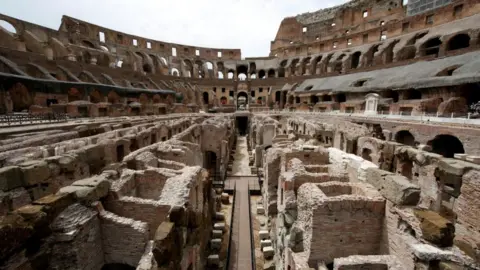Ancient Roman snacks found in Colosseum dig
 Reuters
ReutersSpectators at Rome's ancient gladiator arena, the Colosseum, may have enjoyed snacks of olives, fruit and nuts, archaeologists have found.
Food fragments of figs, grapes, cherries, blackberries, walnuts and more have been unearthed at the site.
Archaeologists also found the bones of bears and big cats that were probably used in the arena's hunting games.
The discoveries were made by archaeologists examining the 2,000-year-old landmark's sewers.
Relics like these provide a snapshot into the "experience and habits of those who came to this place during the long days dedicated to the performances", said Alfonsina Russo, Director of the Colosseum Archaeological Park.
Researchers say bones from bears and lions were probably left by animals that were forced to fight each other and gladiators for entertainment. Smaller animal bones belonging to dogs were also found.
Allow X content?
The study began in January 2021 and involved the clearance of around 70m (230ft) of drains and sewers under the Colosseum, which remains one of Italy's most visited landmarks.
Specialist architects and archaeologists used wire-guided robots to navigate the arena's complex drainage system - aiding their understanding of daily life in Rome as well as ancient hydraulic structures, researchers said.
The Colosseum was the biggest amphitheatre in the Roman Empire, falling into disuse around 523 AD. It was famous for hosting gladiatorial fights and other public spectacles in front of crowds of tens of thousands.
Ancient coins were also discovered in the dig, including 50 bronze coins dating back to the late Roman period, spanning roughly 250-450AD and a silver commemorative coin from around 170-171AD celebrating 10 years of Emperor Marcus Aurelius' rule.
